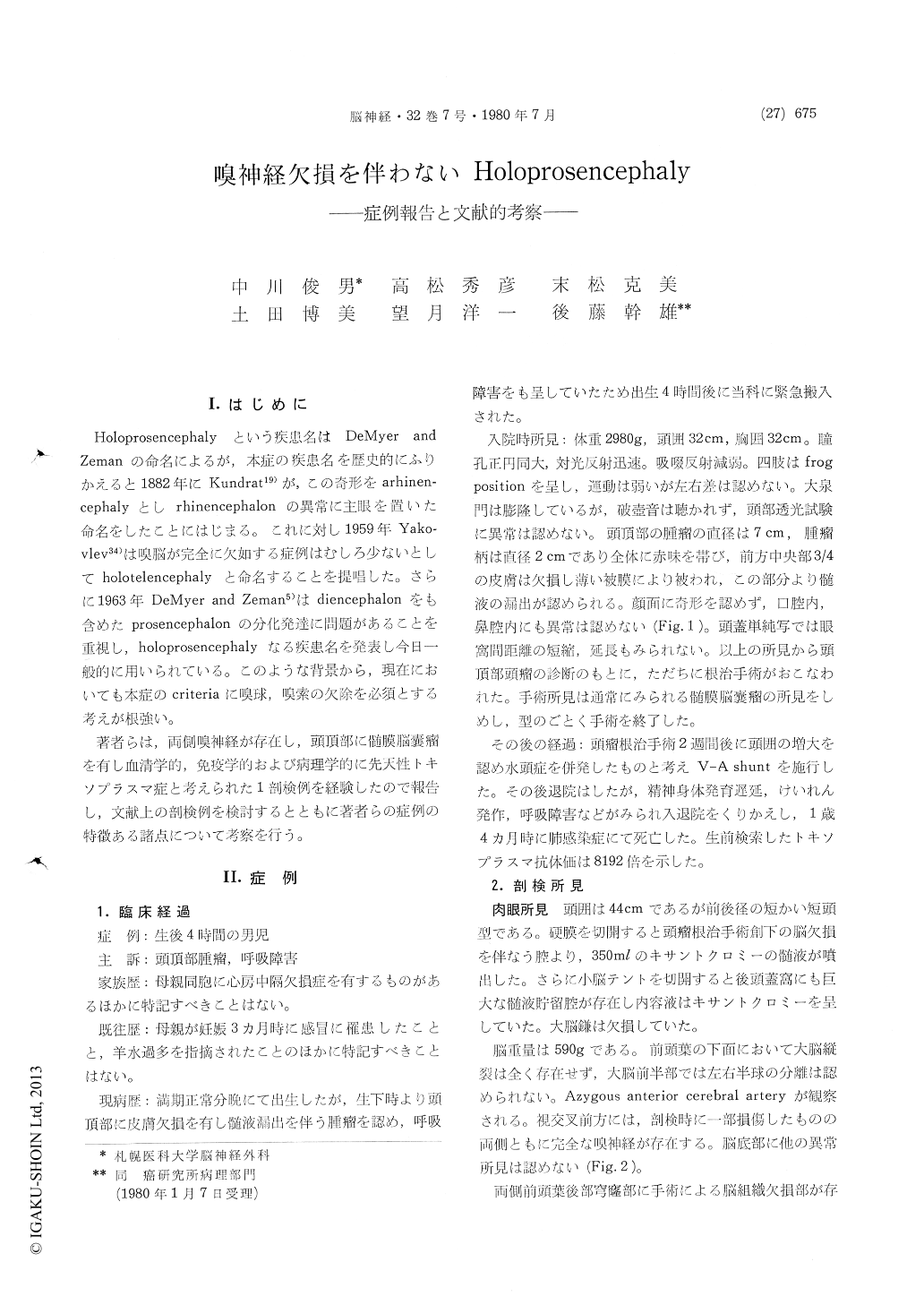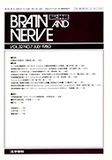Japanese
English
- 有料閲覧
- Abstract 文献概要
- 1ページ目 Look Inside
I.はじめに
Holoprosencephaly という疾患名は DeMyer andZemanの命名によるが,本症の疾患名を歴史的にふりかえると1882年にKundrat19)が,この奇形をarhinen—cephalyとしrhinencephalonの異常に主限を置いた命名をしたことにはじまる。これに対し1959年Yako—vlev34)は嗅脳が完全に欠如する症例はむしろ少ないとしてholotelencephalyと命名することを提唱した。さらに1963年DeMyer and Zeman5)はdiencephalonをも含めたprosencephalonの分化発達に問題があることを重視し,holoprosencephalyなる疾患名を発表し今日一般的に用いられている。このような背景から,現在においても本症のcriteriaに嗅球,嗅索の欠除を必須とする考えが根強い。
著者らは,両側嗅神経が存在し,頭頂部に髄膜脳嚢瘤を有し血清学的,免疫学的および病理学的に先天性トキソプラスマ症と考えられた1剖検例を経験したので報告し,文献上の剖検例を検討するとともに著者らの症例の特徴ある諸点について考察を行う。
The authors reported an autopsy case of holo-prosencephaly with the presence of olfactory nerve, parietal cephalocele and highly positive toxoplasm antibody titer and discussed about some significant points of our case with a review of autopsy cases in the literature.
The patient was admitted to our department 4 hours after birth because of parietal cephalocele. Emergency radical operation was carried out and meningoencephalocystocele was diagnosed histo-logically. After discharge from our department the patient developed upper respiratory tract in-fection repeatedly and his psychosomatic develop-ment was remarkably delayed. The patient expired at 1 year and 4 months of his age because of pulmonary infection.
At autopsy the presence of olfactory nerve and posterior fossa arachnoid cyst were confirmed in addition to the typical findings of semilobar holo-prosencephaly (Table 1).
We investigated 50 reported autopsy cases of holoprosencepaly including our case, according to DeMyer and Zeman's classification (Table 2). On the analysis of 50 cases DeMyer and Zeman's classification as a morphological point of view correlated not to only pathological condition, but also clinical severity and facial abnormality (Table 3).
In the literature only 6 cases of holoprosencephaly with the presence of olfactory nerve were reported (Table 4). This group has no alobar holoprosence-phaly as the severest type of this malformation, rare appearance of severe facial anomaly and rela tively long survival time. The above mentioned findings supported that teratogenic factor might not be so strong in this group. Holoprosencephaly with the presence of olfactory nerve may be found, if teratogenic factor is not enough to make severe type of holoprosencephaly. Many literatures stressed that the absence of olfactory nerve was the most important point of diagnosis of holoprosencephaly but we suggested that the absence of olfactory nerve is not essential to diagnostic criteria of holo-prosencephaly.
The second characteristics of our case is the presence of parietal cephalocele. Only one case of holoprosencephaly with parietal cephalocele was reported in the literature (Table 5). The cephalo-celes of these 2 cases were not ordinary cephalocele due to dysraphia state but it was considered to be dorsal cyst of persistent diencephalic roof.
The third significant point of our case is highly positive toxoplasm antibody titer (8192 time) in his lifetime and pathological findings of small calcium deposits in the cerebral tissue. We sus-pected that the teratogenic factor in our case might be congenital toxoplasmosis.

Copyright © 1980, Igaku-Shoin Ltd. All rights reserved.


